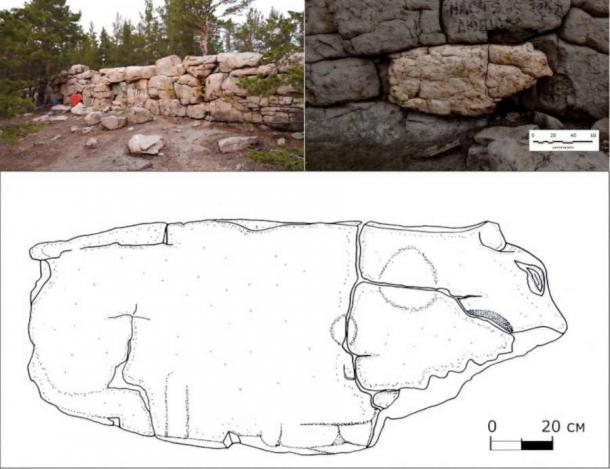
2nd Millenium BC Megalithic Structure - A Sacred Place for Gold Miners?
A team of adventurous researchers has revealed the findings of their study on a remarkable megalithic monument discovered in the picturesque Burabay district of Kazakhstan’s Akmola region. This ancient complex, known to the locals as “Taskamal,” or “stone fortress” in Kazakh, features a monumental architecture that has archaeologists buzzing with excitement. The structure is believed to be closely connected to gold mining activities in the region during the second millennium BC.
A Monumental Design: A Megalithic Structure of Wonder
The research team, who published their study in the journal, Archaeological Research in Asia, left no stone unturned, documenting the monument’s architecture with precision, conducting detailed topographic surveys, and excavating the surrounding area. Their efforts have uncovered a megalithic structure of an amazing design, seamlessly integrated into the rugged terrain.
- 15,000-year-old Gobi Desert Petroglyphs Made By Ancient Turks?
- Evidence of Ancient Megalithic Culture in Massachusetts Revealed

Evidence indicates Taskamal structure in Kazakhstan was a place of worship for Bronze Age miners. (Sergey Yarygin et al./ Archaeological Research in Asia)
Among the standout features of the Taskamal complex is a massive megalithic wall, built with gigantic granite blocks. This formidable wall is accompanied by a central elevated platform, two carefully crafted access ramps, an external platform, several enigmatic lithic stelae whose purpose remains a mystery, and an array of petroglyphs and reliefs that might hold the key to understanding the site’s function and cultural importance.
Preliminary dating suggests that the monument was constructed in the second millennium BC, aligning it with the Late Bronze Age in Central Asia. One of the key indicators helping to date the site is a depiction of a reclining bull, a symbol that plays a crucial role in placing Taskamal within this historical context, reports La Brujula Verde Magazine.
- 4,000-Year-Old Pyramid Found in Kazakhstan Is First Ever on Asian Steppe!
- Valley Filled with Giant Balls Has Geologists and Fringe Scientists Butting Heads

Stone depicting a recumbent bull. (Sergey Yarygin et al./Archaeological Research in Asia)
A Rich Archaeological Landscape: Glittering Gold!
This proposed timeline is even more intriguing when viewed alongside the rich archaeological landscape of the Burabay region. The area is home to approximately 46 Late Bronze Age sites, 90 ancient gold mines, and several cemeteries associated with the Fedorovo, Alakul, and Sargara-Alexeyev cultures, which thrived between 1800 and 900 BC.

Several burials were uncovered at the Taskamal structure in Kazakhstan. (Sergey Yarygin et al./ Archaeological Research in Asia)
Gold has always held a special place in human societies due to its rarity, malleability, and luster. In the Late Bronze Age, gold was not just a material for making jewelry and decorative items; it also symbolized power, status, and religious significance. The control of gold resources was often associated with political power, and those who controlled gold mines could exert significant influence over trade networks and regional politics.
A Sacred Site for Gold Miners?
The researchers speculate, with scientific caution, that the Taskamal complex may have been linked to gold mining activities in the region during the Late Bronze Age. This hypothesis is not only supported by the presence of numerous gold deposits and ancient mining evidence nearby but also by the monumentality of the structure, which implies that it served a significant purpose for the prehistoric communities who built it.
One tantalizing theory is that Taskamal could have functioned as a place of worship for ancient miners, where economic, ritual, and social practices intertwined. If this interpretation proves correct, it would offer a fascinating glimpse into the complex relationships between these elements in Bronze Age societies in Central Asia, reports Arkeonews.
The researchers are quick to acknowledge that there is still much work to be done. They emphasize the need for absolute dating to refine the site’s chronology, geochemical analyses to definitively link the complex to gold mining, and broader regional studies to fully contextualize Taskamal within the vast and intricate archaeological landscape of Central Asia.
Top image: The megalithic wall that is a part of the complex at Burabay, Kazakhstan. Source: Sergey Yarygin et al./ Archaeological Research in Asia
By Sahir Pandey
References
Carvajal, G. 2024. A Megalithic Complex Found in Kazakhstan was a Place of Worship for Gold Miners in the Bronze Age. Available at: https://www.labrujulaverde.com/en/2024/08/a-megalithic-complex-found-in-kazakhstan-was-a-place-of-worship-for-gold-miners-in-the-bronze-age/.
Buyukyildirim, O. 2024. Megalithic structure found in Kazakhstan was probably a place of worship for miners in the Bronze Age. Available at: https://arkeonews.net/megalithic-structure-found-in-kazakhstan-was-probably-a-place-of-worship-for-miners-in-the-bronze-age/.
Yarygin, S., et al. 2024. Megalithic structure from Burabay: Gold mining and cult communities of the Late Bronze Age of Northern Kazakhstan. Archaeological Research in Asia, 39. Available at: https://doi.org/10.1016/j.ara.2024.100536.















